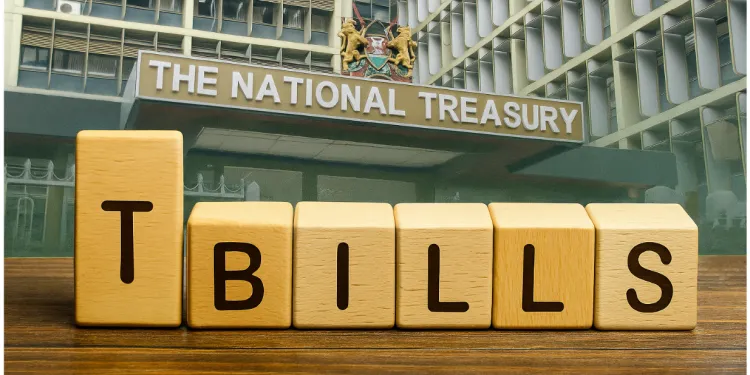The latest auction of Treasury bills (T-bills) in Kenya delivered a dramatic signal: yields on short-term government securities have sunk to their lowest in 36 months, and investor demand is cooling at the short end of the yield curve.
According to the Central Bank of Kenya’s (CBK) weekly bulletin, the 182-day T-bill averaged 7.9851 per cent, marking the first time it has slipped below 8 per cent since December 2021. The 91-day bill cleared at 7.9 per cent, its lowest since June 2022, while the 364-day instrument fetched 9.5 per cent, a level unseen since January 2022.
Build the future you deserve. Get started with our top-tier Online courses: ACCA, HESI A2, ATI TEAS 7, HESI EXIT, NCLEX-RN, NCLEX-PN, and Financial Literacy. Let Serrari Ed guide your path to success. Enroll today.
In the auction, bidders submitted roughly Sh15.1 billion in offers against an advertised target of Sh24 billion, translating to a subscription ratio of about 62.9 per cent. The subdued interest underscores weakening demand for short-dated securities even as the government leans more on debt markets to fund its sprawling budget deficit.
Why Yields Are Declining
Several intertwined factors help explain this sustained decline in T-bill yields over the past year:
- Monetary easing by CBK
The Central Bank has cut its policy (Central Bank Rate, CBR) by a cumulative 275 basis points in 2025. It now stands at 9.5 per cent, helping anchor interest rates lower across the board. This easing has quelled pressure on short-term yields as funding costs ease for banks and institutions. - Soft interbank rates
Interbank lending has remained anchored around 9.5 per cent, reducing the premium investors demand for government paper at the very short end. With liquidity relatively abundant in the banking system, demand for risk-free instruments like T-bills diminishes. - A shift toward longer maturities
The Treasury has increasingly favored reopening fixed-coupon Treasury bonds to extend its debt profile, thereby reducing reliance on short-term bills. This strategy eases upward pressure on short-end yields because demand is being diverted toward medium and long-term bonds. - Investor behavior and sentiment
Some investors appear content to “sit out” in short-term auctions when yields feel unappealing, choosing instead to wait for more attractive opportunities in the bond market. - Macro backdrop and fiscal pressures
In a climate of rising public debt and fiscal strains, investors may demand higher returns on government securities as compensation for risk. However, the downward pressure on yields suggests that expectations of lower rates may be dominating in the near term.
Auction Details & Participation Trends
- The overall auction performance got only ~63 per cent subscription, highlighting weak interest at the short end.
- The 91-day and 182-day bills had particularly weak uptake, while the 364-day instrument drew relatively more interest.
- Some market commentary suggests investors may be holding off at the short end in anticipation of more attractive rates elsewhere.
- This trend echoes a broader shift in investor allocations away from short-term to longer-tenor government securities.
Reopened Bonds: The Government’s Lever
In a reinforcing move, the CBK has announced plans to reopen two fixed-coupon Treasury bonds in October: FXD1/2018/015 (coupon 12.650%, maturing May 2033) and FXD1/2021/020 (13.444%, maturing July 2041), seeking Sh50 billion to support budgetary financing. These reopenings fit into a pattern of issuance in the current FY 2025/26, where the government is increasingly relying on existing long-dated instruments rather than new short-term bills.
Overall gross financing needs for the fiscal year are pegged at Sh1.55 trillion, covering both the projected deficit and maturing obligations. The government aims to borrow Sh901 billion domestically and Sh287.4 billion externally to bridge its fiscal gap.
By end-September, the CBK had already securitized over Sh400 billion via domestic markets, surpassing 40 per cent of its net domestic borrowing target. The trend underscores how much the government is leaning on debt markets to support its fiscal operations.
Secondary Market & Bond Activity Slows
The fallout from the weak auction extended into the secondary market. Bond turnover declined by about 6 per cent in the week ending September, closing at Sh51 billion, compared to Sh54.2 billion the prior week. This softness may reflect reduced price competition as yields settle lower.
On the equities side, the week ending September 25 showed gains—NASI rose 1.6 per cent, NSE 25 gained 1.7 per cent, and NSE 20 added 1.0 per cent—indicating that capital rotation into stocks may also be a factor in the muted bond activity.
One decision can change your entire career. Take that step with our Online courses in ACCA, HESI A2, ATI TEAS 7, HESI EXIT, NCLEX-RN, NCLEX-PN, and Financial Literacy. Join Serrari Ed and start building your brighter future today.
Implications & Risks
For Investors
- Lower returns in the short term: With short-term yields compressed, the risk–reward profile for T-bill investors is less compelling, pushing many toward longer-term bonds or alternative assets.
- Duration risk increases: As more capital moves into longer-dated securities, sensitivity to interest rate changes deepens. Any future surprises in inflation or policy could provoke sharp repricing.
For the Government & Debt Strategy
- Reduced refinancing pressure: By moving away from frequent short-dated rollovers, the government lowers rollover risk and volatility.
- Higher exposure to long-term rate risk: While shifting borrowing to longer maturities helps with liquidity, it also locks in higher coupon costs over time.
- Market dependence: With declining auction participation at the short end, the government becomes more reliant on bond markets, making it sensitive to sentiment and macro shocks.
For Broader Macro Stability
- Interest rate signaling: The fall in yields suggests that markets expect a continued loose or neutral stance from the CBK in the near term.
- Fiscal caution needed: Given the country’s heavy borrowing needs, fiscal discipline remains essential; excessive dependence on debt risks crowding out private investment.
- Creditworthiness sensitivity: Declines in demand or yield volatility may prompt increased scrutiny from credit rating agencies and external financiers.
What to Watch Going Forward
- Next T-bill auctions: Will participation stabilize, or will the trend of weak subscription persist?
- Bond reopenings: The success of the upcoming FXD1/2018/015 and FXD1/2021/020 offerings will signal how deeply investors are willing to rotate into long-term paper.
- Policy rate path: Whether the CBK holds, cuts, or even tightens policy could shift yield curves across all tenors.
- Fiscal signals: Any signs of slippages or extra-budgetary spending could spook markets and push yields higher.
- Credit rating outlook: Continued pressure on yields and debt strains heighten sensitivity to external assessments.
Conclusion
The auction results for September have crystalized a broader shift in Kenya’s debt markets: yields on short-term government instruments have plunged to multi-year lows, while investor participation at the short end diminishes. The government is reacting in kind, prioritizing longer-dated bond issuances to manage its fiscal burden and debt profile. For market participants, the low-yield environment on T-bills is pushing scrutiny toward duration choices, return expectations, and macro risks.
Ready to take your career to the next level? Join our Online courses: ACCA, HESI A2, ATI TEAS 7 , HESI EXIT , NCLEX – RN and NCLEX – PN, Financial Literacy!🌟 Dive into a world of opportunities and empower yourself for success. Explore more at Serrari Ed and start your exciting journey today! ✨
Track GDP, Inflation and Central Bank rates for top African markets with Serrari’s comparator tool.
See today’s Treasury bonds and Money market funds movement across financial service providers in Kenya, using Serrari’s comparator tools.
Photo source: Google
By: Montel Kamau
Serrari Financial Analyst
2nd October, 2025
Article, Financial and News Disclaimer
The Value of a Financial Advisor
While this article offers valuable insights, it is essential to recognize that personal finance can be highly complex and unique to each individual. A financial advisor provides professional expertise and personalized guidance to help you make well-informed decisions tailored to your specific circumstances and goals.
Beyond offering knowledge, a financial advisor serves as a trusted partner to help you stay disciplined, avoid common pitfalls, and remain focused on your long-term objectives. Their perspective and experience can complement your own efforts, enhancing your financial well-being and ensuring a more confident approach to managing your finances.
Disclaimer: This article is for informational purposes only and does not constitute financial advice. Readers are encouraged to consult a licensed financial advisor to obtain guidance specific to their financial situation.
Article and News Disclaimer
The information provided on www.serrarigroup.com is for general informational purposes only. While we strive to keep the information up to date and accurate, we make no representations or warranties of any kind, express or implied, about the completeness, accuracy, reliability, suitability, or availability with respect to the website or the information, products, services, or related graphics contained on the website for any purpose. Any reliance you place on such information is therefore strictly at your own risk.
www.serrarigroup.com is not responsible for any errors or omissions, or for the results obtained from the use of this information. All information on the website is provided on an as-is basis, with no guarantee of completeness, accuracy, timeliness, or of the results obtained from the use of this information, and without warranty of any kind, express or implied, including but not limited to warranties of performance, merchantability, and fitness for a particular purpose.
In no event will www.serrarigroup.com be liable to you or anyone else for any decision made or action taken in reliance on the information provided on the website or for any consequential, special, or similar damages, even if advised of the possibility of such damages.
The articles, news, and information presented on www.serrarigroup.com reflect the opinions of the respective authors and contributors and do not necessarily represent the views of the website or its management. Any views or opinions expressed are solely those of the individual authors and do not represent the website's views or opinions as a whole.
The content on www.serrarigroup.com may include links to external websites, which are provided for convenience and informational purposes only. We have no control over the nature, content, and availability of those sites. The inclusion of any links does not necessarily imply a recommendation or endorsement of the views expressed within them.
Every effort is made to keep the website up and running smoothly. However, www.serrarigroup.com takes no responsibility for, and will not be liable for, the website being temporarily unavailable due to technical issues beyond our control.
Please note that laws, regulations, and information can change rapidly, and we advise you to conduct further research and seek professional advice when necessary.
By using www.serrarigroup.com, you agree to this disclaimer and its terms. If you do not agree with this disclaimer, please do not use the website.
www.serrarigroup.com, reserves the right to update, modify, or remove any part of this disclaimer without prior notice. It is your responsibility to review this disclaimer periodically for changes.
Serrari Group 2025












